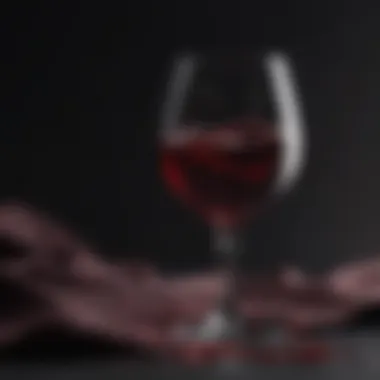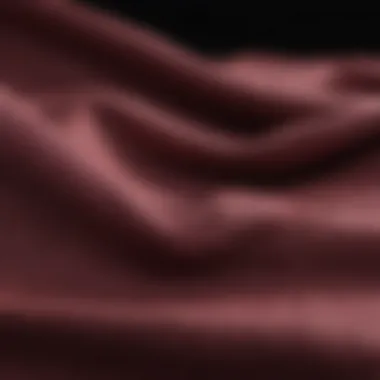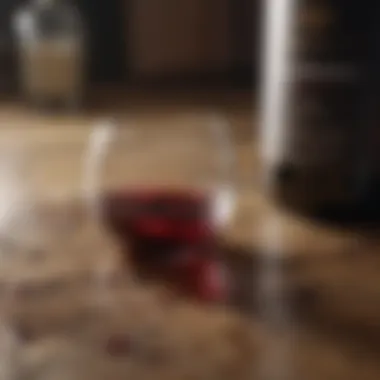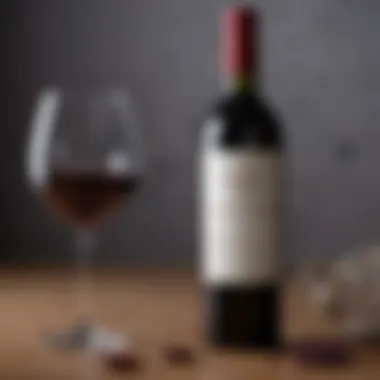Proven Methods to Eliminate Red Wine Stains from Clothes


Intro
When it comes to enjoying a glass of red wine, mishaps are bound to happen. One moment you’re savoring that rich, velvety flavor, and the next, you find yourself staring in horror as the deep, crimson liquid seeps into your favorite shirt. Red wine stains are not simply a cosmetic issue; they can be a source of stress and frustration for many.
Understanding the nature of stains is essential. Red wine contains tannins and pigments that easily attach to fabrics. When dealt with promptly and correctly, however, these stains can be effectively treated, leaving your clothing looking as good as new. This article details both immediate action steps and long-term remedies to counteract the unwelcome aftermath of these spills. From household remedies most homeowners have on hand to specialized commercial products designed for the job, we will explore a range of techniques aimed at tackling this common dilemma.
In addition to methods of stain removal, we will delve into preventative approaches. After all, a wise adage goes, "an ounce of prevention is worth a pound of cure." Equip yourself with knowledge, and you’ll not only be able to fight red wine stains but also enhance your overall wardrobe maintenance strategies.
Preface to Red Wine Stains
Red wine stains are an unfortunate but all too common mishap, especially for those who enjoy a glass or two with dinner or at social events. The significance of effectively addressing these stains cannot be overstated. Red wine is notorious for its deep color and potent pigments, which means that once it lands on a cherished garment, it can quickly become a source of distress.
Knowing how to treat these stains right from the start can save a lot of heartache later. In this article, we will explore the best techniques for combating red wine stains, merging practical advice with the science behind why they occur. A robust understanding of the stain's nature allows one to select the most suitable removal methods, reducing the risk of permanent damage to your clothing.
Many people may question why red wine stains seem to create a sense of urgency. The answer is simple—prompt action is key. When red wine seeps into fabric, it interacts with the fibers, potentially leading to a permanent mark if not treated swiftly and properly.
Being well-prepared with knowledge of both immediate actions and longer-term solutions gives you the upper hand. For instance, if you are hosting a gathering, having a strategy for any potential spills not only reflects well on you, but it also ensures that the event remains relaxed and enjoyable.
Additionally, by recognizing the preventative measures discussed later in the article, you can arm yourself against the possibility of stains before they even occur. This knowledge is particularly valuable for homeowners and party hosts, who may find themselves fretting over unexpected accidents, distracting from the fun of entertaining.
"An ounce of prevention is worth a pound of cure" – this old adage holds true, especially when it comes to keeping those wine stains at bay!
In the subsequent sections, we will delve into the makeup of red wine and why removing such stains often feels like a Herculean task.
Immediate Action Steps
When it comes to red wine stains, the actions you take in the first moments after the spill can make all the difference. Taking immediate action not only minimizes the stain size but also significantly increase the chances of complete removal. Remember, time is of the essence and considering the choices you make can save your favorite attire from an untimely demise.
Blotting the Stain
Blotting is a fundamental step that some may overlook in the heat of the moment. It involves using a clean cloth or paper towel to gently dab the stain without rubbing it. Rubbing can spread the stain, embedding it deeper into the fibers, making the situation worse instead of better.
The key here is to blot, not rub. Start from the outside of the stain and work your way in to prevent it from spreading. It’s akin to putting out a small fire with a blanket; you don’t want to fan the flames. The absorbent material pulls the wine up and away from the clothing. If you’re dealing with a thicker fabric, a little more pressure might be necessary, but always keep it gentle.
A good tip is to use cold water to moisten the region first. This helps in loosening the wine from the fabric fibers, further aiding the blotting process. Make sure your cloth or paper towel is clean for maximum efficacy; an already dirty cloth can introduce new stains, defeating the purpose altogether.
Avoiding Common Mistakes
While dealing with stains, it’s easy to trip over your own feet with common blunders. Understanding these mistakes can streamline your stain removal efforts, saving time and headaches.
- Ignoring the Stain Promptly: Delay might seem harmless, but the longer the stain sits, the tougher it becomes to shift.
- Wiping: Wiping can be tempting; however, it's a surefire way to push the wine deeper into the fabric instead of lifting it out. Remember, patience pays off.
- Choosing Hot Water: Using hot water can set the stain, making it practically permanent. Stick with cold water initially.
- Using the Wrong Fabric: When blotting, avoid colored cloths as dye transfer can happen. Always opt for white or colorfast materials.
In short, be proactive and avoid rash actions. Even in a bustling social event, take a moment to assess your approach carefully. After all, prevention is better than cure, and a little knowledge goes a long way when confronting wine mishaps.
The quicker you act, the higher the chances that the stain will come out, transforming your clothing from a casualty of a night out into a gleaming success.


Household Remedies for Wine Stains
When it comes to dealing with red wine stains, homeowners often seek methods that are not only effective but also cost-efficient. Household remedies have gained recognition in this regard. These methods are accessible and often use common items found in most kitchens. Knowing how to use these remedies correctly is key to maximizing their potential.
In addition, these remedies are typically more environmentally friendly than commercial options. You do not need to worry about harsh chemicals that could damage your fabrics or pose health risks. Plus, using ingredients like salt or vinegar feels more natural, which can be comforting in a world flooded with synthetic solutions.
Here’s a closer look at some household remedies that could be a game changer when it comes to tackling those stubborn wine stains.
Salt and Other Absorbents
Salt is well-known for its ability to absorb moisture, and when a red wine spill occurs, it can work wonders if applied promptly. Sprinkling a generous amount of salt over the stain can help draw out the wine, especially if done right away.
To use salt effectively:
- Act quickly: The sooner you address the stain, the better the result. It’s like a race against time—don’t fall behind.
- Apply liberally: Cover the stain thoroughly with salt, allowing it to sit for several minutes.
- Rinse off: After some time, gently rinse the fabric with cold water. You might see the salt take some of the stain away!
Other natural absorbents include cornstarch and baking soda. They can be just as effective, acting similarly to salt by soaking up the liquid. Count on them to help if salt isn't handy.
Baking Soda Paste Application
Baking soda is not just for making your fridge smell fresh; it can also be a formidable ally against red wine stains. When mixed with water, it forms a paste that targets stains beautifully. There’s a simple technique for applying this remedy:
- Make your paste: Combine three parts baking soda with one part water until you achieve a thick consistency.
- Apply generously: Spread the paste over the stain, ensuring it covers the area fully.
- Let it sit: Give it time—leave the paste on for at least 30 minutes or more, if possible. This allows the baking soda to absorb the stain effectively.
- Rinse thoroughly: Finally, rinse the fabric with cool water to remove any excess paste.
However, do keep in mind that this method works best on cotton fabrics. Curiosity can lead to trying it on other types of material, but caution is advised!
Vinegar and Dish Soap Mixture
The combination of white vinegar and dish soap creates a powerful stain-fighting duo. Vinegar's acidity helps break down the pigments within red wine, while dish soap works to lift the stain from the fabric. To use this mixture effectively:
- Mix the solution: Combine one cup of white vinegar with one cup of dish soap in a bowl. Stir it well.
- Blot and apply: Using a clean cloth, blot the mixture onto the stain. Make sure to work from the outside in to avoid spreading the stain.
- Wait and rinse: Allow the solution to sit for about 20 minutes. Then rinse with cold water.
This concoction is simple and requires no special ingredients, making it a favorite among those battling red wine stains. Plus, it proves effective on a variety of fabrics, from linens to polyesters, depending on how you treat it.
Epilogue
Commercial Stain Removers
When dealing with red wine stains, sometimes the home remedies just don't cut it. This is where commercial stain removers come into play. These products are designed specifically to tackle tough stains, and many times, they offer more power and effectiveness than your average kitchen concoction. The importance of understanding commercial options cannot be overstated; with so many choices available, selecting the right one can make the difference between salvaging a beloved piece of clothing and declaring it a loss.
Considering ingredients, effectiveness, and application methods are essential factors. Many commercial products target red wine stains by leveraging enzymes, surfactants, or oxygen-based whiteners, each of which works in its own way to break down the components of the stain. Researching and knowing which product works best on various fabric types also saves time and frustration.
Choosing the Right Product
Selecting the right commercial stain remover involves a few key pointers. First off, always check the label. Look for products explicitly mentioning red wine stains or those containing specific ingredients, like enzymes. Note also the fabric types that the product is recommended for. Some products, while potent, may not be gentle enough for delicate fabrics such as silk.
Another thing to consider is the format of the stain remover. Sprays are popular for their convenience, allowing for precise application. However, gels or powders can provide a more concentrated treatment, especially in the event of a heavily soiled area. Read reviews or seek recommendations from fellow homeowners—user experiences can shine a light on which products deliver results.


You might want to check out options like Wine Away, OxiClean MaxForce, or Zout, known amongst enthusiasts as effective solutions. They are tailored for wine stains and often have specialty formulations.
Application Techniques
Once you have chosen the right product, application is crucial. The following steps will help ensure an effective treatment:
- Always test on a hidden area: Before applying on the stain, dab a small amount on a less visible part of the fabric to ensure no discoloration occurs.
- Pre-treat the stain: Generously apply the stain remover directly onto the affected area. Allow it to sit for a few minutes, as the product needs time to work its magic.
- Gently rub the fabric: With a soft cloth or sponge, lightly massage the fabric. Avoid aggressive scrubbing, as that may spread the stain or damage the fabric.
- Rinse or blot: Depending on the product instructions, rinse the fabric with cool water or blot it with a clean cloth to remove the stain remover.
- Wash as usual: Finally, launder the fabric according to the manufacturer's care instructions, keeping your fingers crossed that the stain's gone for good.
"A little prep and the right product can work wonders against red wine stains that threaten your attire."
With these techniques, commercial stain removers can shoulder most of the hard work, allowing you to enjoy that glass of red without sweating the small stuff.
Washing and Treatment
Effective treatment of red wine stains hinges greatly on the methodology of washing and the subsequent treatment of the fabric. This component is essential not just for the immediate remedy but also for preventing any lingering effects of the stain. Proper washing is the groundwork that potentially determines the success of previous efforts, whether you've used household remedies or commercial products. Ignoring these guidelines could mean wasting your time, energy, and resources.
Proper Washing Guidelines
Having done all the right things in removing the stain, it is crucial to follow proper washing practices that will not undo your hard work. Here’s a layered approach to ensure the best results:
- Use Cold Water: Always opt for cold water when washing stained garments. Hot water can set stain particles more firmly into the fabric fibers, making them much harder, if not impossible, to remove later.
- Gentle Cycle: Choose a gentle cycle for delicate fabrics. This reduces the aggressive tumbling that can damage fibers and potentially exacerbate the stickiness of residual stains.
- Optimal Detergent: Select a high-quality detergent specifically formulated for stain removal. Look for products that highlight their ability to treat wine stains; enzymes like protease can help break down organic compounds found in red wine.
- Pre-Treatment or Stain Stick: It can be beneficial to use a pre-treatment spray or stick on the stained area before washing. Let it sit for about 5-10 minutes, as this give the solution a fair chance to work its magic.
Remember, it's vital to check the care labels on your clothing before proceeding. Ignoring these instructions could lead to irreversible damage.
Air Drying vs. Machine Drying
After washing, the method of drying can influence the final outcome concerning the stain's visibility. Machine drying might seem like the quicker option, but it can prove detrimental after a wash. Here are the important notes:
- Air Drying: This method is often the preferred choice when dealing with previously stained items. It allows for a slower, natural evaporation which decreases the risk of heat setting any lingering stain.
- Inspect Before Drying: Always inspect the fabric before using a the dryer. If any trace of the stain remains, throwing it in the hot dryer can lock it in for good. If in doubt, air drying is usually a safer choice.
- Gentle Looks Attractive: Air drying can also offer a chance for a more gentle treatment. There’s less chance of wear and tear on delicate fabrics which may otherwise shrink or lose shape in a dryer.
"Stains are like unwelcome guests; they can be tricky to evict without the right strategy, especially when drying."
Ultimately, the washing and treatment phase serves as a gatekeeper for the success of all prior stain-removal attempts. Treat it with the seriousness of a fine art, and you just might restore that favorite garment from the brink of being a complete write-off.
Prevention Strategies
In the battle against red wine stains, prevention is your best ally. Being proactive not only saves you time and effort but also helps protect your precious fabrics from the unforgiving grasp of red wine. By adopting effective prevention strategies, you can shield your clothing from potential mishaps during a dinner party or a casual gathering with friends.
You might be wondering what specific elements come into play here. Let's break it down:
- Understanding the Environment: The context in which you enjoy your wine can go a long way in preventing stains. Being aware of your surroundings helps you to anticipate spills and to counteract them effectively.
- Embracing Advanced Protective Gear: Investing in certain protective measures can keep your wardrobe safe from the clutches of wine. With various solutions emerging on the market, you're sure to find an appropriate match for your lifestyle needs.
- Cultivating Mindfulness: A little awareness can make a big difference. When pouring or passing around a drink, being conscious about your actions can minimize spill risks.
The benefits of preventing red wine stains can't be overstated. Not only does it reduce the stress of cleaning up afterward, but it also extends the life of your clothing. You want to keep that lovely dress or those new trousers looking pristine, don’t you? Plus, prevention strategies help in maintaining your overall confidence when hosting a gathering.
Let's delve deeper into these tactics:


Use of Wine Shields or Stains Guards
Wine shields and stains guards are clever innovations designed to minimize the risk of stains. They are often made from materials that repel liquid, creating a barrier between your wine and your garment. These handy tools are typically lightweight, easy to carry, and can be employed during any occasion where wine is likely to be served.
Consider placing a portable wine shield on your lap or draping it over the arm of your chair while you sip your drink. It's a silent guardian, keeping potential drips at bay. Additionally, many wine shields are designed with a stylish appearance, so they can complement rather than clash with your outfit.
Some examples of product options include disposable spill guards that can fit under your glass during events or reusable cloths that can be draped over clothing. These solutions affirm that with a bit of foresight, you can enjoy your wine without the worry of permanent blemishes gracing your attire.
Mindful Pouring Techniques
The way you pour your wine plays a significant role in avoiding stains. It might seem simple, but mastering a few techniques can change the game.
Here are some mindful pouring tips to keep in mind:
- Keep the Glass Steady: Ensuring a stable hand can prevent unnecessary spills.
- Pour at a Lower Height: Bringing the bottle closer to the glass before pouring reduces the chances of a dribble.
- Tilt Correctly: A gentle tilt aids in a smooth pour, eliminating abrupt movements that may cause splashes.
Maintaining a bit of focus while pouring wine might take a conscious effort at first, but in time it can become second nature.
By integrating these prevention strategies into your routine, you're taking control of your environment. Make these practices second nature as you savor your wine. The more you implement these methods, the less worry you'll have about those stubborn red wine stains. In the end, being prepared is half the battle.
Dealing with Old Stains
Dealing with old stains can feel like an uphill battle. Once red wine has had time to settle into fabric, it makes a strong case for hanging around. The longer a stain sits, the more tenacious it becomes, often leading many to throw in the towel altogether. However, understanding how to handle these stubborn remnants can save a beloved garment and the money it took to buy it. This section dives into the essential elements of facing old stains, exploring strategies to assess their viability and treatment options.
Assessment of Old Stain Viability
Before embarking on any cleaning mission, it’s important to assess if the old stain is still viable. Not all stains are created equally; some may have faded into mere shadows, while others have aged like fine wine. Here are a few points to keep in mind when examining the situation:
- Color and Texture: Take a close look at the stain. Is it still vibrant, or has it dulled down over time? A vibrant stain is more likely to respond to treatment than an old, faded one.
- Fabric Type: The material can make a world of difference in treatment. Delicate fabrics may require gentler approaches or specialized products. On the other hand, sturdier materials might withstand more aggressive techniques.
- Past Treatments: If a stain has been previously treated, it’s essential to consider what was used. Some chemicals can set stains further. If a stain remains persistent after a few at-home approaches, it might be time to call in the professionals.
Ultimately, the goal is to gauge whether any treatment will be worthwhile or if the fabric is beyond saving.
Re-Treatment Options
Once the assessment is complete and you've determined that the stain is still viable, it’s time to roll up the sleeves and get to work. Here are some viable re-treatment options for dealing with those pesky old stains:
- Soaking: Sometimes, a good soak can loosen stubborn stains. Using a mixture of cold water and dish soap can work wonders. Just be sure to avoid hot water, which can set the stain further.
- Hydrogen Peroxide: This gentle oxidizer is a friend to old red wine stains. Mix it with equal parts of baking soda to create a paste. Apply it abundantly to the stain, letting it sit for about 30 minutes before rinsing with cold water.
- Professional Enzyme Cleaners: For those stains that refuse to budge, consider specialty cleaners with protein-targeting enzymes. These products break down the organic material in the stain and can be especially useful for old ones that have been hanging around too long.
- Repeating Methods: If a treatment fails, don’t be too quick to dismiss it. Sometimes, a second attempt with a different approach can yield a better outcome. Patience is key, especially when it comes to older stains.
Culmination
Understanding how to effectively tackle red wine stains is not just an academic endeavor; it's a practical skill that can save one from wardrobe disasters. Accidents happen at the dinner table or during lively gatherings, and knowing the right steps to respond promptly can prevent permanent damage.
Recap of Effective Techniques
- Immediate Action Steps: The first few moments after a spill are critical. Blotting not only absorbs excess liquid but also reduces the stain depth. Avoiding pitfalls such as rubbing the stain increases the chances of successful removal.
- Household Remedies: Common kitchen items like salt, baking soda, and vinegar can be powerful allies in stain removal. These remedies are cheap, accessible, and can often yield satisfying results without the need for commercial products.
- Commercial Stain Removers: When household applications don't quite cut it, specialized stain removers are available. Learning how to choose and apply the right product can make all the difference.
- Proper Washing and Treatment: Utilizing correct washing techniques and knowing whether to opt for air drying or machine drying is vital in stain management.
- Dealing with Old Stains: Identifying the viability of old stains can be tricky, yet knowing how to re-treat them can sometimes provide the second chance needed.
Encouragement for Future Prevention
As the saying goes, an ounce of prevention is worth a pound of cure. With this in mind, adopting a few preventive strategies can go a long way in avoiding those dreaded red wine stains:
- Use Wine Shields: Investing in protective products, like wine shields or stain guards, can create a barrier between the fabric and potential stains.
- Mindful Pouring Techniques: When enjoying a glass of red, take extra care while pouring. The less chance for spills, the fewer stains you'll have to deal with later.
In summary, the importance of knowing how to remove and prevent red wine stains cannot be overstated, especially for homeowners, party hosts, and those who appreciate a tidy wardrobe. Mastering these techniques not only saves time and money but also helps maintain the integrity and appearance of your clothing. Armed with this knowledge, you'll be well-equipped to handle any wine spill like a pro.



